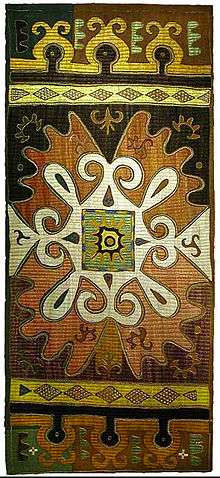Choli

A choli (Hindi Nepali: चोली, Gujarati: ચોળી, Marathi: चोळी, ravike Tamil: ரவிக்கை, Telugu: రవికె(ravike), although choli is the preferred word Telugu Kannada: ರವಿಕೆ) is a midriff-baring blouse or upper garment in the Indian sari costume worn in India, southern Nepal, Pakistan, Sri Lanka, Bangladesh, and other countries where the sari is worn. It is also part of the ghagra choli costume of India.
Evolution



The choli evolved from ancient Stanapatta, it was part of three-piece attire worn during ancient period.[1] The Antriya lower garment, Uttariya veil worn over shoulder or head and Stanapatta a chestband, which finds mentioned in Sanskrit literature and Buddhist Pali literature during 6th century B.C.[2] Rajatarangini (meaning the 'river of kings'), a tenth-century literary work by Kalhana, states that the Choli from the Deccan was introduced under the royal order in Kashmir.[3] Early cholis were front covering, tied at the back. Choli of this type are still common in state of Rajasthan.[4] Pre-Christian era paintings of Maharashtra and Gujarat are considered the first recorded examples of choli.[5] Poetic references from works like Silapadikkaram indicate that during the Sangam period 3rd century BC - 4th century CE in ancient South India, a single piece of clothing served as both lower garment and upper shawl.[6] Based on paintings and sculpture, the Stanapatta evolved into choli by 1st century A.D in various region styles[7] In Nepal it's known as cholo, in Southern India it's known as ravike both of these styles are tied in the front unlike Northern Indian choli which is tied at the back. In parts of Hindi-belt, mostly in Rajasthan, Haryana and Uttar pradesh women wore vest-like garment known as Kanchli over choli, this complete attire is known as Poshak.[8]
Historical paintings
 Women in Choli and Antariya CE 320 Gupta Empire.
Women in Choli and Antariya CE 320 Gupta Empire. Women in Choli CE 320 Gupta Empire. Early form of Choli tied at the back with front covering.
Women in Choli CE 320 Gupta Empire. Early form of Choli tied at the back with front covering. Dancing girl in Kurta/Salwar-like Choli Gupta Empire.
Dancing girl in Kurta/Salwar-like Choli Gupta Empire. Kalpasutra Manuscript ca.1375–1400. Example of early form of full sleeve choli.
Kalpasutra Manuscript ca.1375–1400. Example of early form of full sleeve choli.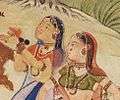 Detail of Vasant Ragini, Rajastani painting 1500s showing early form of choli tied at the back.
Detail of Vasant Ragini, Rajastani painting 1500s showing early form of choli tied at the back. Bhagavata Purana manuscript ca.1525–40
Bhagavata Purana manuscript ca.1525–40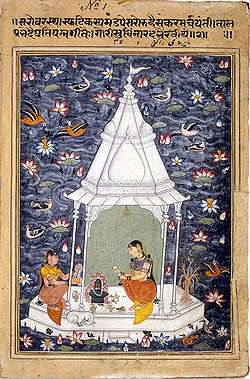 Bhairavi Ragini, Manley Ragamala manuscript ca.1610.
Bhairavi Ragini, Manley Ragamala manuscript ca.1610. Female musicians at Aurangzeb's wedding - Mughal ca.1636.
Female musicians at Aurangzeb's wedding - Mughal ca.1636. Krishna flirting with the Gopis, to Radhas sorrow - Kangra Painting ca.1760. Full sleeve choli and bodics worn in Himalayan states of India.
Krishna flirting with the Gopis, to Radhas sorrow - Kangra Painting ca.1760. Full sleeve choli and bodics worn in Himalayan states of India.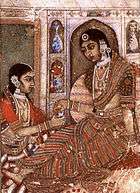 Lady being offered wine, Deccan, 1600 AD
Lady being offered wine, Deccan, 1600 AD
Historic photographs
 Women in Gagra Choli
Women in Gagra Choli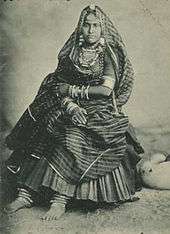 Women in gagra choli
Women in gagra choli Tamil girl in choli
Tamil girl in choli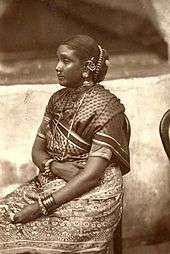 Tamil women in choli
Tamil women in choli Bengali girl in full sleeve choli (1880)
Bengali girl in full sleeve choli (1880) Sri Lankan woman in choli (1880)
Sri Lankan woman in choli (1880) Marathi woman in choli
Marathi woman in choli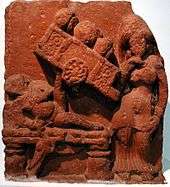 Plaque depicting ancient form of long choli and gagra worn during Gupta Empire
Plaque depicting ancient form of long choli and gagra worn during Gupta Empire Woman in Sindhi choli 1845
Woman in Sindhi choli 1845
Changing times
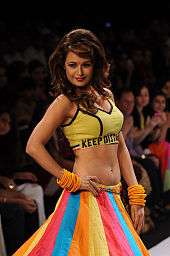
During the 1960s, a woman was still not considered a 'lady' if her neckline was cut too daringly and bared too much, especially if she wore her sari pallu pulled to one side, giving a glimpse of her bosom. A lady of honour ideally covered her back and upper arms with a blouse made of a thicker fabric. Of course, not every woman followed the norm. In the 1970s and 1980s, the blouses went knotty, criss-crossed with a deep cut, and even shone through the sheer saree.[9] Anupama Raj, a boutique owner commented, "There is a very real need to re-invent the choli so that it can be worn with a variety of outfits. Just as we see the choli to be a deconstructed form of the blouse, we need to deconstruct the choli. Only then, will it be acceptable internationally." Bobby Malik, an exporter-turned-designer commented,"The choli is the most sensuous of all garments created for women. It not only flatters the feminine form, but also brings out the romanticism in a woman. But where Indian designers have failed is at giving it an international look and making it still more beautiful."[10] The late Khushwant Singh in his book Sex Scotch and Scholarship stated, "A well-cut blouse worn with the saree elevates the bosom and exposes the belly to below the navel."[11][12]
Today the entire approach towards the choli is adventurous. Their metamorphosis has taken cholis from being demure and sedate to daring, with adventurous tailoring and innovative necklines, such as halter, tubes, backless or stringed.[13] Designer Manish Malhotra said, "Since most young people follow a healthy gym routine and are at ease with their bodies, they want to look different and still be effortlessly comfortable. They like to travel and carry a sense of Indianness around them."[9] Designer Vikram Phadnis said, "It's also to do with the fact that the new age woman is well-traveled, well-read and open to experimentation."[14] Sonora Kabir, another Delhi-based designer commented, "Normally, the choli is supposed to hover around the navel area. But if you crop the lower edges and combine it with a funky design — beads, embroidery etc.,— it would be chic enough to be worn over jeans or a pair of trousers."[10]
Fabrics
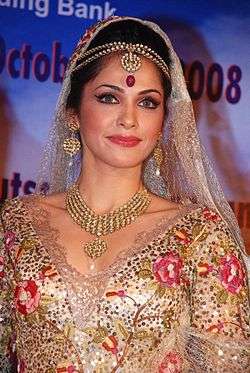
Traditionally, the choli has been made from the same fabric as the sari, with many sari producers adding extra length to their products so that women can cut off the excess fabric at the end of the sari and use it to sew a matching choli. Cholis can be made from many fabrics. For everyday wear, cotton-based materials such as terry-cot and silk cotton are widely considered the most comfortable. Chiffon, silk, crepe and satin are best suited for formal occasions.[14] The ideal fabric for cholis in the summer is chiffon and georgette.[15] Sheer and other transparent fabrics are considered to add glamour, provided they come with an opaque lining in the right places. Cholis made out of velvet and suede are considered the deadliest faux pas in the Indian culture.[14]
Colours
The colour of the choli is usually matched with the colour of the sari. Currently, the cholis are worn in contrast colours to that of the colour of the sari.[16] Colours like black, white, navy blue, deep purple, crimson red, lemony yellow, hot pink and sea green are mostly preferred.[14] The colour of the moment is shades of blue and aqua. Designers also recommend that the skin tone should be taken into consideration before choosing what colour the blouse should be. Fairer skins are at an advantage as they can carry any colour. Darker hues such as navy and black can make one appear slimmer. Fluorescent colours are mostly avoided.[17]
Other than the colour, prints are also given significance. Embroidery on blouses that use threads of contrasting shades is considered trendy.[18] For formal occasions, embroidered blouses are still very popular.[17] When wearing a crepe sari, richly embroidered, sheer cholis are preferred.[19] Other embellishments that could make an appearance on your blouse include sequins, kundan work and crystals.[14]
See also
References
- ↑ Prachya Pratibha, 1978 "Prachya Pratibha, Volume 6", p.121
- ↑ Agam Kala Prakashan, 1991 "Costume, coiffure, and ornaments in the temple sculpture of northern Andhra", p.118
- ↑ Katiyar, Vijai Singh (2009). Indian saris : traditions, perspectives, design. New Delhi: Wisdom Tree in association with National Institute of Design, Ahmedabad. p. 211. ISBN 9788183281225. Retrieved 31 October 2015.
- ↑ India: past & present – Prakash Chander – Google Books. Google Books. Retrieved 13 November 2011.
- ↑ Prachya Pratibha, 1978 "Prachya Pratibha, Volume 6", p.121
- ↑ Linda Lynton, Sanjay K. Singh (2002) "The Sari: Styles, Patterns, History, Techniques.", p.40
- ↑ Prachya Pratibha, 1978 "Prachya Pratibha, Volume 6", p.121
- ↑ Bhandari, Vandana (2005). Costume, textiles and jewellery of India: traditions in Rajasthan. Mercury Books. p. 84. ISBN 9780811810845.
- 1 2 Tiwari, Nimisha (June 19, 2011). "The choli lowdown!". Times of India. Retrieved 21 March 2012.
- 1 2 Roy, Sumona (August 31, 2002). "Deconstructing the choli into daring designs". The Tribune. Retrieved 13 April 2012.
- ↑ Khushwant Singh (2012). Sex, Scotch & Scholarship. HarperCollins Publishers. ISBN 9350292424.
- ↑ Florine Roche. "Extolling the Virtues of Saree". Dajiworld.com. Retrieved 1 February 2015.
- ↑ "Vidya Balan puts plunge cholis on fashion map". Times of India. December 20, 2011. Retrieved 12 April 2012.
- 1 2 3 4 5 Sarkar, Neeti (June 26, 2010). "Choli ke peeche". The Hindu. Retrieved 21 March 2012.
- ↑ Singh, A. D. (March 10, 2012). "Summer breezers". Deccan Chronicle. Retrieved 21 March 2012.
- ↑ Parekh, Mitali (August 8, 2011). "Try some feisty blouses!". Times of India. Retrieved 21 March 2012.
- 1 2 Sujata Assomull (July 19, 1997). "The upper hand". The Indian Express. Retrieved 21 March 2012.
- ↑ Lakshmi, V. (October 6, 2009). "Sari fad: Mix 'n' match". Times of India. Retrieved 21 March 2012.
- ↑ "Choli check". Times of India. July 21, 2010. Retrieved 21 March 2012.
External links
 Media related to Choli at Wikimedia Commons
Media related to Choli at Wikimedia Commons


